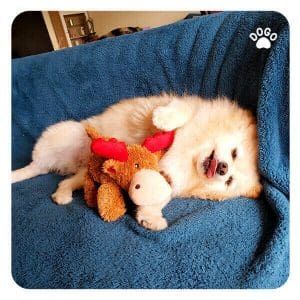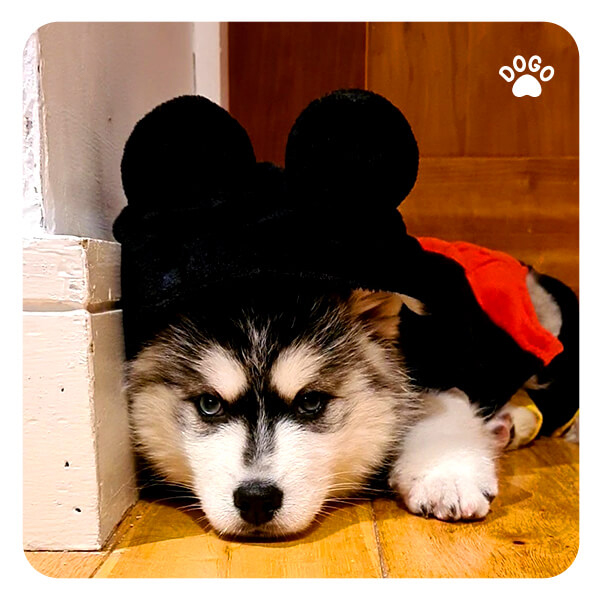 Dogs are social animals and need contact with other people and representatives of their species. However, it is unavoidable that your dog has to be left alone in the house. Dogs that are not used to this, can be under enormous stress, and they will react to it in various ways. Some will cope with the stress and simply go to sleep, while others may destroy furniture or bark at the door. How long can a dog be left alone in the house? How do you deal with separation anxiety?
Dogs are social animals and need contact with other people and representatives of their species. However, it is unavoidable that your dog has to be left alone in the house. Dogs that are not used to this, can be under enormous stress, and they will react to it in various ways. Some will cope with the stress and simply go to sleep, while others may destroy furniture or bark at the door. How long can a dog be left alone in the house? How do you deal with separation anxiety?
Dog Alone at Home
Every dog is different, so everyone experiences loneliness differently, depending on their personality. Some dogs can be pretty independent and will easily be left alone for a few or even several hours, while other pets may struggle with this. However, with proper socialization and habituation, every dog should be able to handle at least a few hours of their parents’ absence.
It is important to note that breed and temperament also play a significant role in how long a dog can be left alone. For instance, some breeds, such as the Bichon Frise and the Chihuahua, are known to suffer from separation anxiety and may not handle being alone for extended periods. Similarly, a dog with a more anxious or shy temperament may also struggle with loneliness. It is crucial to understand your dog’s specific needs and personality and tailor your approach to meet them. If you are unsure about how long your dog can be left alone or how to help them cope with separation anxiety, it is always best to consult a veterinarian or a professional dog trainer.
Dog’s Age
The age of your pooch also determines to some extent how long your pet can be left alone. For example, puppies should be gradually accustomed to being alone and taught to occupy themselves. As for adult dogs, most of them, with proper training and a comfortable environment, can be left alone for up to 8-10 hours when you are at work. If you’re not home all day and don’t get a chance to see your dog for at least a little while, have a neighbor or friend stop by to walk your pooch and play with them a bit.
It is important to note that senior dogs may require more attention and care when left alone. As dogs age, they may develop health issues that require medication or special treatment. It is crucial to ensure that your senior dog is comfortable and has everything they need while you are away. You may also consider hiring a pet sitter or dog walker to check on your senior dog during the day. Additionally, it is recommended to provide your senior dog with a comfortable and easily accessible sleeping area, as they may have difficulty moving around or climbing stairs.
What is Separation Anxiety?
It is a serious disorder that is quite common in companion dogs that live with people. It results in panic when the dog is left alone in the house. Pets then try to cope in their own way with the stress associated with it. They often vocalize, bark, destroy objects, scratch at doors, bite furniture, etc. These reactions are natural for separation anxiety. The dog is simply trying to relieve the tension. However, all of these behaviors bring the dog only temporary relief. The stress and fear come back after a while, so the dog again looks for solutions to reduce them. Separation anxiety often appears in pets adopted from shelters. These are dogs that usually suffer from a lack of a sense of security. Once they have built a bond with their new parent, they may experience every departure as another loss. Separation anxiety can have a profound impact on a dog’s overall well-being and quality of life. If left untreated, it can lead to destructive behavior, aggression, and even self-harm. That’s why it’s essential to address the issue as soon as possible.
Boredom
 Often boredom while the dog parent is away and the behaviors the dog exhibits are immediately recognized as separation anxiety. Sometimes, it is hard to distinguish, but separation anxiety is closely related to the sense of security. For example, suppose you don’t provide the dog with adequate physical and mental activity before you leave or while you are away. In that case, your pet may simply seek to occupy themselves. In addition to physiological needs, every dog has a range of other needs. Depending on the breed, these may vary. For example, one dog will need a lot more exercise, while another will need mental fatigue to be happy. Additionally, it’s crucial to establish a routine and provide your dog with a safe, comfortable space where they can relax and feel secure when you’re not home. Therefore, if you do not provide your pet with the opportunity to meet these needs, they will find their solution. For example, they may start destroying furniture or other objects.
Often boredom while the dog parent is away and the behaviors the dog exhibits are immediately recognized as separation anxiety. Sometimes, it is hard to distinguish, but separation anxiety is closely related to the sense of security. For example, suppose you don’t provide the dog with adequate physical and mental activity before you leave or while you are away. In that case, your pet may simply seek to occupy themselves. In addition to physiological needs, every dog has a range of other needs. Depending on the breed, these may vary. For example, one dog will need a lot more exercise, while another will need mental fatigue to be happy. Additionally, it’s crucial to establish a routine and provide your dog with a safe, comfortable space where they can relax and feel secure when you’re not home. Therefore, if you do not provide your pet with the opportunity to meet these needs, they will find their solution. For example, they may start destroying furniture or other objects.
How to Deal with Separation Problems
1. Interactive Games and Toys
When it comes to the problem of boredom, the solution is much more straightforward. We recommend simply focusing more on your dog’s needs. For example, if you cannot go for a long walk with your pup before work or organize some mental activity, consider providing your dog with interactive games.
 An excellent way to organize the dog’s time while we are away, for example, are natural chews or Kong-type chews, to which you can put something tasty. Dog chewing and licking significantly reduces the level of cortisol (stress hormone) in their body. It is also good to organize many sniffing games for your dog, for example, by hiding your dog’s favorite treats around the house or in a sniffing mat. Interactive and olfactory toys do not have to be expensive. You can also make them yourself! It will require little time, willingness, and creativity.
An excellent way to organize the dog’s time while we are away, for example, are natural chews or Kong-type chews, to which you can put something tasty. Dog chewing and licking significantly reduces the level of cortisol (stress hormone) in their body. It is also good to organize many sniffing games for your dog, for example, by hiding your dog’s favorite treats around the house or in a sniffing mat. Interactive and olfactory toys do not have to be expensive. You can also make them yourself! It will require little time, willingness, and creativity.
2. Consultation with a Behaviorist
In the case of separation anxiety, the problem is much more complex and requires a lot of commitment from you. The best solution is to visit a behaviorist, who will explain how to deal with your particular case and show step by step what to do. Every dog is different, so help in this case should be tailored individually. Some dogs will require much more time to work through anxiety than others. Working with anxious dogs is based primarily on building their confidence and a sense of security when alone.
Baby Steps
Step I
The first step in examining your dog’s behavior is to record it while you are away. It is essential to see how long your pet has been exhibiting the behavior, whether they can calm down for a while, etc.
Step II
The second step is to accustom your dog to your absence gradually. In the beginning, it can be only a few minutes of separation. Slowly you should extend this period while observing the dog and changes in their behavior. It is important not to show the dog that something terrible is going on, i.e., do not hug the dog, speak in a sad voice, do not say goodbye too many times. Make sure to behave in the same way when you return. The dog should understand that it is something ordinary and even boring. While you are away, your pup should also have a chance to do something interesting. Therefore, when they are bored, they can play interactive games that will keep them occupied for a longer time and calm them down. Of course, in the initial stages, when your furry companion experiences heavy stress, they may not be interested in any activities at all.
Step III
 The following steps depend on the progress of the dog. For this reason, it is so vital that an experienced person (behaviorist) observe the behavior of your dog and adapt the pace and methods of work to a particular case. You can, of course, try to work on your own. Still, suppose you do not see any progress after a while. In that case, we recommend making an appointment with an expert. After all, it’s about your comfort, as well as your pet’s well-being.
The following steps depend on the progress of the dog. For this reason, it is so vital that an experienced person (behaviorist) observe the behavior of your dog and adapt the pace and methods of work to a particular case. You can, of course, try to work on your own. Still, suppose you do not see any progress after a while. In that case, we recommend making an appointment with an expert. After all, it’s about your comfort, as well as your pet’s well-being.
[/fusion_text]



